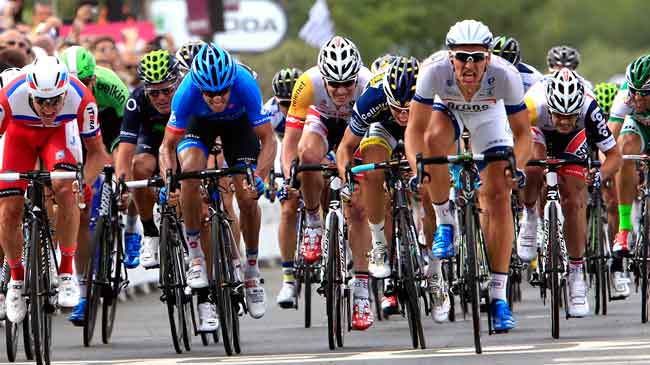Sprinting for Success

Having a decent sprint finish is important. The bottom line is that a lot of races end in a sprint.
Who doesn’t dream of beating everyone else and throwing their arms in the air – whether it’s on the Champs-Elysées or across a line painted on the road that marks the end of your evening handicap race?
Everyone can improve their sprinting, even if they think they are hopeless at it. One day a week doing some specific training can bring about an improvement.
First of all we take a look at 3 different types of sprint and tactics to cross the line 1st.
1) Mass Bunch Sprint – Position is everything in the final few kilometres. You have to choose which wheels to follow and make sure that, once you are in the position you want, you don’t surrender it to someone else. Keep off the front, out of the wind, hold your place by being assertive. Stay close to wheel in front. You might have to give someone a nudge to keep your place but don’t do anything dangerous. No one wants to cause a crash, but for some guys, a gentle shove is the only language they understand. Then, it’s all a matter of timing. Making sure you come of the wheel at the right time. You should also take note of which way the wind is coming from and always try to pass on the sheltered side. When sprinting, aim for a point past the line – don’t sprint for the line. If you sprint for it, you may start decelerating in the last few meters.
2) Small group – If your the fastest in the group it shouldn’t matter if you’re sitting first or last in the line, you should have the speed to win. If someone attacks and you feel you’re the strongest in the group, you’ve got to react. By the time you think ‘should I chase them?’ you’ve lost. Hesitation is the enemy of the sprinter – react, don’t think.
You may not know the opposition, but there are clues that can tell you who’s going to bring strong at the finish. Watch for any changes in a rider’s rhythm. If they looked smooth when you first got away but the shoulders start rocking a bit, they may be feeling tired. If someone closes a gap easily and you struggle to get on his wheel, you can assume he’s a strong guy. It’s important to look for all the clues before you get into the final straight.
3) Two-up sprint – ”Again, if you’re strong you may not be worried about leading out. You can hug one side of the road and force the other guy to come by you on the side you want him to. If there’s a crosswind from the left, hug the right-hand side of the road and make him come off your wheel straight into the wind.
Obviously it’s advantageous to be in second place coming to the final. If you like a long sprint go early, but give it 100%. If you jump you have to be fully committed or you’ll lose. Or you can wait for the other guy to lead it out and come round him late. Again, tactics are no use if your legs aren’t strong. They can make up for a little bit but can’t do it all for you.
Gearing Up – Gear selection is very important. Novice riders tend to go for a big gear, slamming the chain all the way down the cassette. While rolling a big gear will be effective for high speeds, using a smaller gear will allow for better acceleration. Until you get on top of your gear you may find riders overtaking. A rider who can quickly accelerate and open up a gap may often hold off the over-geared riders to the line. With practice, it is possible to make an initial jump and then shift up in the final 100 meters once you get up to speed.
Sprint Training
Session 1 – High revs in small gears. Do 15 seconds going really hard out of the saddle in 39 x 17, getting up to just above 30mph. That’s about 140 revs per minute, which is very quick. Then sit in the saddle for the last six seconds. This will teach your muscles to work quickly when out of the saddle. Do 4 or 5 reps of this with fully recovery between intervals.
Session 2 – Sprint set in a big gear, 53×11/12. Ideal on a good flat straight stretch of road. Start quite slow, in the big gear, and kick as hard as you can, sprint for approx 300 meters. You should do between 6 and 10 reps, which would be sprinting full-gas for 3 kilometres, which is a really full-on effort.
Session 3 – Declining time sprints. after a good warm up, sprint as hard as you can for 60 seconds, then 50 seconds, 40, 30 and 20. Allow your heart rate to recover before starting the next sprint.
Session 4 – Repeat accelerations. In the closing stages of a race, you may have to jump and accelerate a few times before the final sprint. Some riders do this deliberately to take the sting out of the legs of the power sprinters who only have one big effort to give. Accelerate out of the saddle for 10 pedal revolutions. Sit down for 10 rpm. Repeat this, in and out of the saddle, for 3 minutes per set. After full recovery repeat this set up to 5 times.
Session 5 – Motor paced training. This is a more advanced session and requires you to have a partner who can pace you on a moped/motor bike. You will start off tucked in behind the bike and increase the speed up to 35 – 40 mph and then try to come off its wheel and sprint by it.
Conclusion
Sprinting is a learnt skill. Yes you need some guts and courage, but when it comes down to the nitty gritty, it is a technical skill that has to be backed up by confidence. Make sure you make it a part of your cycle training programme.
Leave a Comment cancel
This site uses Akismet to reduce spam. Learn how your comment data is processed.






